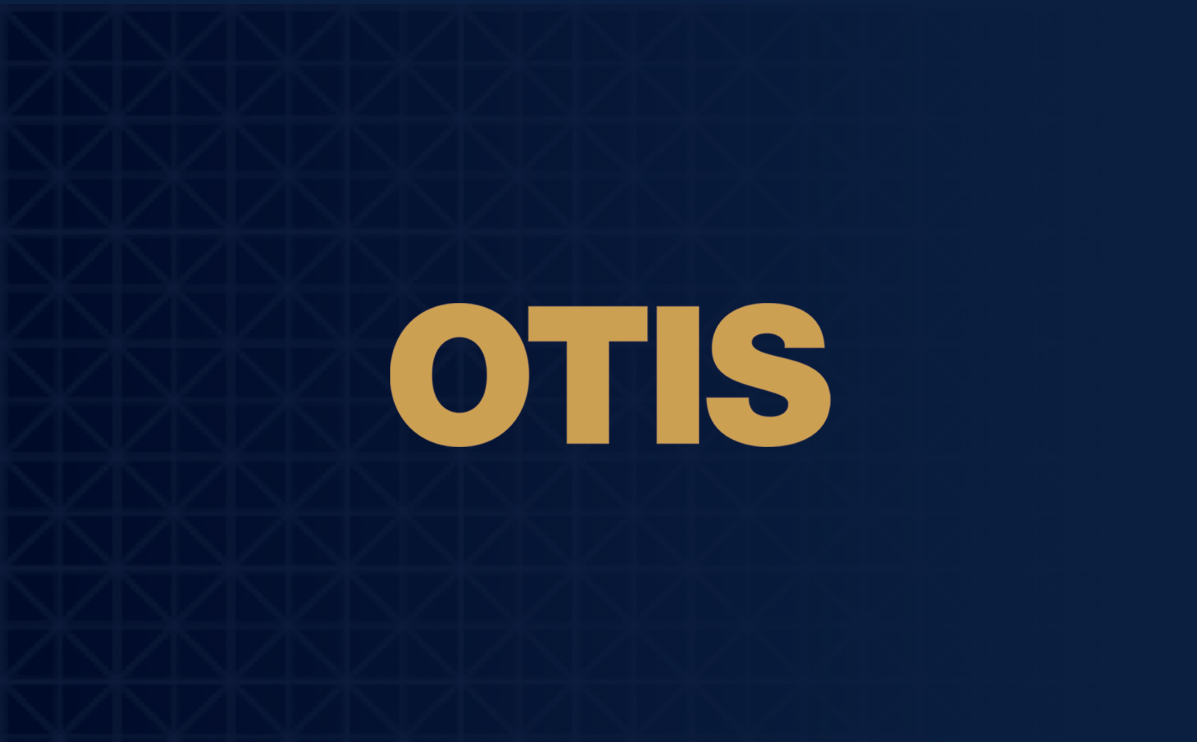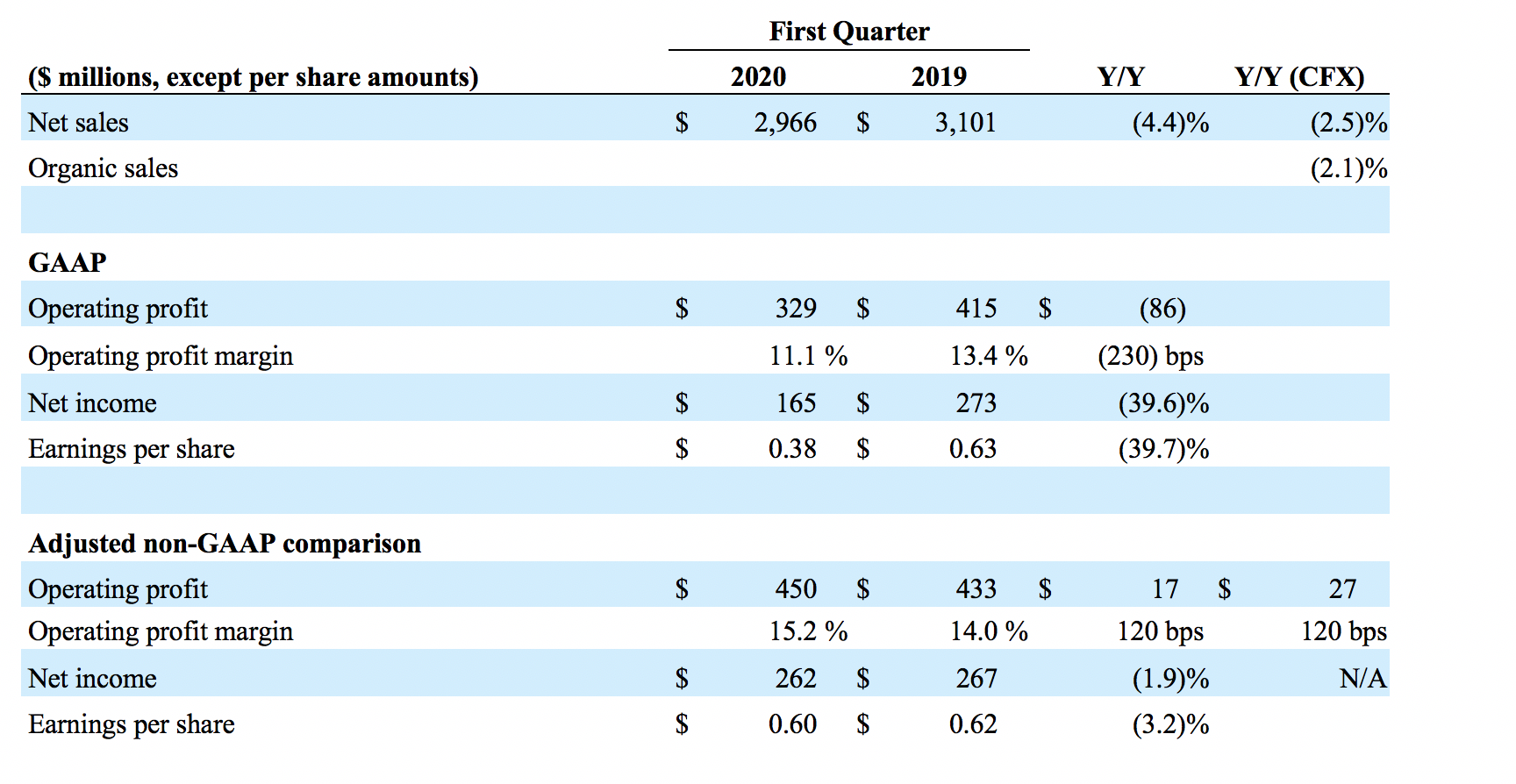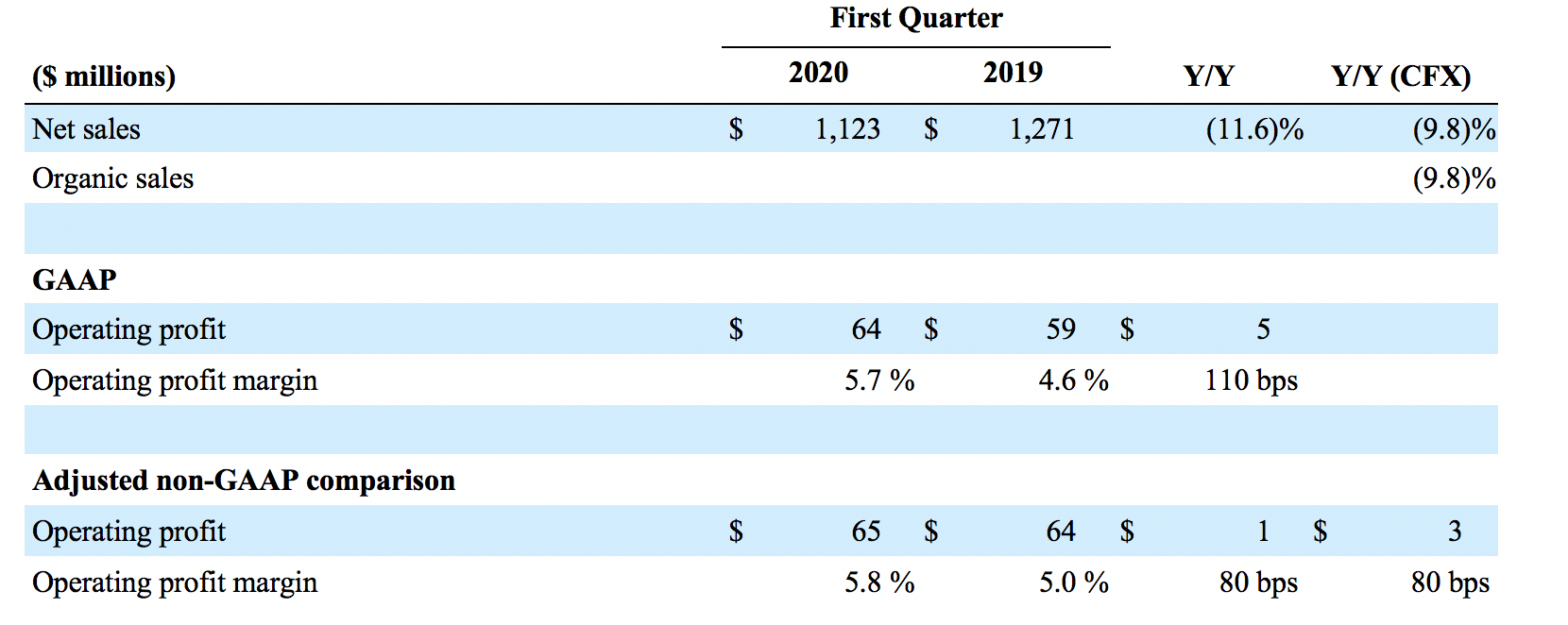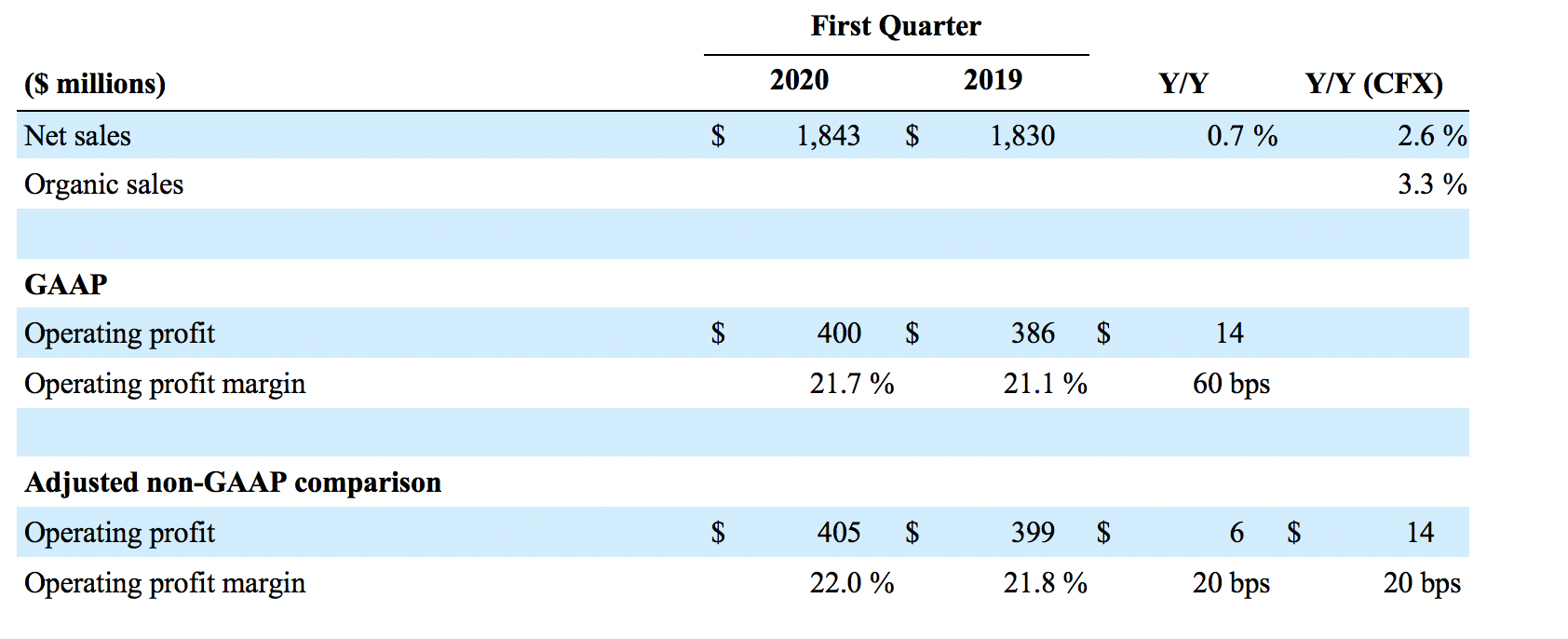SEARCH
Otis Reports First Quarter 2020 Results
Otis Reports First Quarter 2020 Results
- May 6, 2020
- FARMINGTON, CT, UNITED STATES

Delivers strong quarter with organic Service segment sales growth and operating profit margin expansion in both New Equipment and Service segments
• Net sales of $3.0 billion, down 4.4%; organic sales down 2.1% with 3.3% organic Service sales growth.
• GAAP operating profit down 20.7% to $329 million and margin of 11.1% contracted 230 basis points.
• Adjusted operating profit up 3.9% to $450 million and adjusted margin expanded 120 basis points to 15.2%.
• New equipment orders were flat at constant currency; up 5.6% excluding China.
• GAAP cash flow from operations of $159 million; free cash flow of $120 million.
• Full year outlook revised to reflect the anticipated impacts of COVID-19; organic sales expected to be down 3 to 7% and adjusted operating profit down $25 to $175 million at constant currency.*
FARMINGTON, Conn., May 6, 2020 – Otis Worldwide Corporation (NYSE:OTIS) reported first quarter 2020 net sales of $3.0 billion, a decrease of 2.1% organically versus the prior year. GAAP operating profit decreased 20.7% to $329 million with margin contraction of 230 basis points (bps) to 11.1%. Adjusted operating profit increased 3.9% to $450 million with margin expansion of 120 basis points to 15.2%. GAAP earnings per share (EPS) decreased 39.7% to $0.38 and adjusted EPS decreased 3.2% to $0.60.
"Otis delivered a strong first quarter, while navigating COVID-19 related challenges. The strength of our business was demonstrated by continued organic Service sales growth, New Equipment backlog growth, and margin expansion in both the New Equipment and Service segments. Despite this unprecedented global health crisis, our colleagues rose to the occasion, providing essential services to our customers, while also supporting each other, passengers and our local communities around the world," said President and CEO Judy Marks. "While we are revising our 2020 guidance to reflect the anticipated impacts created by this pandemic, the fundamentals of our business are solid and we remain confident in our long-term growth strategies."
Key Figures

First quarter net sales of $3.0 billion decreased 4.4% versus the prior year, with a 2.1% decline in organic sales, 1.8% headwind from foreign exchange and 0.5% impact from divestitures. Sales decline in the New Equipment segment due to the impact of COVID-19 was partially offset by continued strength in the Service segment.
GAAP operating profit of $329 million decreased $86 million from the prior year with segment operating profit growth of $19 million more than offset by a $67 million nonrecurring charge related to a fixed asset impairment, $32 million of nonrecurring costs associated with the separation from United Technologies and $22 million of incremental public company standalone costs. GAAP operating profit margin contracted 230 basis points to 11.1%.
Adjusted operating profit of $450 million increased $17 million and $27 million at constant currency. Earnings growth at constant currency was driven by segment operating profit growth of $17 million, lower corporate costs and the absence of unfavorable transactional foreign exchange impact from the prior year. Adjusted operating profit margin expanded 120 basis points to 15.2% with expansion in both the New Equipment and Service segments.
GAAP EPS of $0.38 decreased $0.25 driven by the decline in operating profit, a higher effective tax rate and noncontrolling interest. Adjusted EPS of $0.60 decreased $0.02 with adjusted operating profit growth and favorable net interest cost more than offset by a higher adjusted tax rate and noncontrolling interest.
New Equipment Segment

In the first quarter, sales of $1.1 billion decreased 11.6% with a 9.8% decline in organic sales and a 1.8% impact from foreign exchange. Organic sales declined in all major regions with a double digit decline in Asia, primarily due to the impact of COVID-19 in the region, and a high single digit decline in the Americas.
GAAP operating profit increased $5 million to $64 million and adjusted operating profit increased $1 million as the impact from lower volume, primarily in Asia from the impact of COVID-19, was more than offset by strong material productivity and lower commodity prices. GAAP and adjusted operating profit margin expanded 110 and 80 basis points, respectively.
New Equipment orders were flat at constant currency with double digit growth in the Americas and mid-single digit growth in EMEA offset by a decline in Asia. Excluding China, orders increased 5.6% at constant currency. On a rolling twelve month basis, orders increased slightly.
Service Segment

In the first quarter, sales of $1.8 billion increased 0.7% as organic sales growth of 3.3% was partially offset by a 2.6% headwind from foreign exchange and the impact of net acquisitions and divestitures. Organic maintenance and repair sales increased 2.5%, with growth in all major regions, and organic modernization sales increased 6.8%.
GAAP operating profit increased $14 million to $400 million and adjusted operating profit increased $6 million to $405 million as the benefit from increased volume, favorable pricing and mix and productivity was partially offset by labor cost inflation and an $8 million headwind from foreign exchange. GAAP and adjusted operating profit margin expanded 60 and 20 basis points, respectively.
Cash and Capital Deployment

First quarter cash from operations of $159 million decreased $138 million versus prior year primarily driven by $67 million from a tax prepayment, $32 million of nonrecurring separation payments and $22 million of incremental public company standalone costs. First quarter free cash flow of $120 million decreased $149 million versus prior year, including an $11 million increase in capital expenditures.
Outlook*
Otis is updating its full year outlook to reflect the anticipated impacts of the COVID-19 pandemic.
• Net sales down 6 to 10%.
• Organic sales down 3 to 7%.
◦ Organic New Equipment down 5 to 10%
◦ Organic Service down low to mid-single digits
• Adjusted operating profit down $25 to $175 million at constant currency and down $85 to $235 million at actual currency.
• Adjusted effective tax rate ~32%.
• Free cash flow conversion 110 to 120%.
*Note: When we provide outlook for organic sales, adjusted operating profit, adjusted effective tax rate and free cash flow on a forward-looking basis, a reconciliation of the differences between the non-GAAP expectations and the corresponding GAAP measures generally is not available without unreasonable effort. See “Use and Definitions of Non-GAAP Financial Measures” below for additional information.
About Otis
Otis is the world's leading elevator and escalator manufacturing, installation and service company. We move 2 billion people a day and maintain more than 2 million customer units worldwide, the industry's largest maintenance portfolio. Headquartered in Connecticut, USA, Otis is 69,000 people strong, including 40,000 field professionals, all committed to meeting the diverse needs of our customers and passengers in more than 200 countries and territories worldwide. For more information, visit www.otis.com and follow us on LinkedIn, Instagram, Facebook and Twitter @OtisElevatorCo.
Use and Definitions of Non-GAAP Financial Measures
Otis Worldwide Corporation (“Otis”) reports its financial results in accordance with accounting principles generally accepted in the United States ("GAAP"). We supplement the reporting of our financial information determined under GAAP with certain non-GAAP financial information. The non-GAAP information presented provides investors with additional useful information, but should not be considered in isolation or as substitutes for the related GAAP measures. Moreover, other companies may define non-GAAP measures differently, which limits the usefulness of these measures for comparisons with such other companies. We encourage investors to review our financial statements and publicly-filed reports in their entirety and not to rely on any single financial measure. A reconciliation of the non-GAAP measures (referenced in this press release) to the corresponding amounts prepared in accordance with GAAP appears in the attached tables. These tables provide additional information as to the items and amounts that have been excluded from the adjusted measures.
Organic sales, adjusted selling, general and administrative (“SG&A”) expense, earnings before interest taxes and depreciation (“EBITDA”), adjusted EBITDA, adjusted operating profit, adjusted net income, adjusted earnings per share (“EPS”), adjusted effective tax rate and free cash flow are non-GAAP financial measures.
Organic sales represents consolidated net sales (a GAAP measure), excluding the impact of foreign currency translation, acquisitions and divestitures completed in the preceding twelve months and other significant items of a non-recurring and/or nonoperational nature (“other significant items”). Management believes organic sales is a useful measure in providing period-to-period comparisons of the results of the Company’s ongoing operational performance.
Adjusted SG&A expense represents SG&A expense (a GAAP measure), excluding restructuring costs, other significant items and allocated costs for certain functions and services previously performed by United Technologies Corporation (“UTC”) prior to our separation (“UTC allocated costs”) and including estimated standalone public company costs, as though Otis’ operations had been conducted independently from UTC (“standalone costs”). Standalone costs are based on quarterly estimates determined during Otis’ annual planning process.
Adjusted operating profit represents income from continuing operations (a GAAP measure), excluding restructuring costs, other significant items and allocated costs for certain functions and UTC allocated costs and estimated standalone costs.
Adjusted net income represents net income from continuing operations (a GAAP measure), excluding restructuring costs and other significant items and UTC allocated costs and including standalone costs, estimated adjustments to non-service pension expense, net interest expense and tax as if Otis was a standalone public company (“standalone operating income adjustments”). Adjusted EPS represents diluted earnings per share from continuing operations (a GAAP measure), adjusted for the per share impact of restructuring, other significant items and standalone operating income adjustments.
The adjusted effective tax rate represents the effective tax rate (a GAAP measure) adjusted for the tax impact of restructuring costs, significant items and the tax impact of the additional adjustments (standalone costs, additional interest expense and non-service pension expense).
EBITDA represents net income from operations (a GAAP measure), adjusted for noncontrolling interests, income tax expense, net interest expense, non-service pension expense and depreciation and amortization. Adjusted EBITDA represents EBITDA, as calculated above, adjusted for the impact of restructuring, other significant items and UTC allocated costs including estimated standalone costs. Management believes that adjusted SG&A, EBITDA, adjusted EBITDA, adjusted operating profit, adjusted net income, adjusted EPS and the adjusted effective tax rate are useful measures in providing period-to-period comparisons of the results of the Company’s ongoing operational performance as if it had been a standalone company.
Additionally, GAAP financial results include the impact of changes in foreign currency exchange rates (AFX). We use the non-GAAP measure “at constant currency” or “CFX” to show changes in our financial results without giving effect to period-to-period currency fluctuations. Under U.S. GAAP, income statement results are translated in U.S. dollars at the average exchange rate for the period presented. Management believes that this non-GAAP measure is useful in providing period-to-period comparisons of the results of the Company’s ongoing operational performance.
Free cash flow is a non-GAAP financial measure that represents cash flow from operations (a GAAP measure) less capital expenditures. Management believes free cash flow is a useful measure of liquidity and an additional basis for assessing Otis’ ability to fund its activities, including the financing of acquisitions, debt service, repurchases of common stock and distribution of earnings to shareholders.
When we provide our expectations for organic sales, adjusted operating profit, adjusted net income, adjusted effective tax rate, adjusted EPS and free cash flow on a forward-looking basis, a reconciliation of the differences between the non-GAAP expectations and the corresponding GAAP measures (expected diluted EPS from continuing operations, operating profit, the effective tax rate, net sales and expected cash flow from operations) generally is not available without unreasonable effort due to potentially high variability, complexity and low visibility as to the items that would be excluded from the GAAP measure in the relevant future period, such as unusual gains and losses, the ultimate outcome of pending litigation, fluctuations in foreign currency exchange rates, the impact and timing of potential acquisitions and divestitures, and other structural changes or their probable significance. The variability of the excluded items may have a significant, and potentially unpredictable, impact on our future GAAP results.
Cautionary Statement
This communication contains statements which, to the extent they are not statements of historical or present fact, constitute “forward-looking statements” under the securities laws. From time to time, oral or written forward-looking statements may also be included in other information released to the public. These forward-looking statements are intended to provide management’s current expectations or plans for Otis’ future operating and financial performance, based on assumptions currently believed to be valid. Forward-looking statements can be identified by the use of words such as “believe,” “expect,” “expectations,” “plans,” “strategy,” “prospects,” “estimate,” “project,” “target,” “anticipate,” “will,” “should,” “see,” “guidance,” “outlook,” “confident” and other words of similar meaning in connection with a discussion of future operating or financial performance or the separation and distribution. Forward-looking statements may include, among other things, statements relating to future sales, earnings, cash flow, results of operations, uses of cash, dividends, share repurchases, tax rates and other measures of financial performance or potential future plans, strategies or transactions of Otis following its separation from United Technologies Corporation, including the estimated costs associated with the separation and distribution and other statements that are not historical facts. All forward-looking statements involve risks, uncertainties and other factors that may cause actual results to differ materially from those expressed or implied in the forward-looking statements. For those statements, Otis claims the protection of the safe harbor for forward-looking statements contained in the U.S. Private Securities Litigation Reform Act of 1995. Such risks, uncertainties and other factors include, without limitation: (1) the effect of economic conditions in the industries and markets in which Otis and its businesses operate in the U.S. and globally and any changes therein, including financial market conditions, fluctuations in commodity prices, interest rates and foreign currency exchange rates, levels of end market demand in construction, the impact of weather conditions, pandemic health issues (including COVID-19 and its effects, among other things, on global supply, demand, and distribution disruptions as the outbreak continues and results in an increasingly prolonged period of travel, commercial and/or other similar restrictions and limitations), natural disasters and the financial condition of Otis’ customers and suppliers; (2) challenges in the development, production, delivery, support, performance and realization of the anticipated benefits of advanced technologies and new products and services; (3) future levels of indebtedness, including indebtedness incurred in connection with the separation, and capital spending and research and development spending; (4) future availability of credit and factors that may affect such availability, including credit market conditions and Otis’ capital structure; (5) the timing and scope of future repurchases of Otis’ common stock, which may be suspended at any time due to various factors, including market conditions and the level of other investing activities and uses of cash; (6) delays and disruption in delivery of materials and services from suppliers; (7) cost reduction efforts and restructuring costs and savings and other consequences thereof; (8) new business and investment opportunities; (9) the anticipated benefits of moving away from diversification and balance of operations across product lines, regions and industries; (10) the outcome of legal proceedings, investigations and other contingencies; (11) pension plan assumptions and future contributions; (12) the impact of the negotiation of collective bargaining agreements and labor disputes; (13) the effect of changes in political conditions in the U.S. and other countries in which Otis and its businesses operate, including the effect of changes in U.S. trade policies or the United Kingdom’s withdrawal from the European Union, on general market conditions, global trade policies and currency exchange rates in the near term and beyond; (14) the effect of changes in tax, environmental, regulatory (including among other things import/export) and other laws and regulations in the U.S. and other countries in which Otis and its businesses operate; (15) the ability of Otis to retain and hire key personnel; (16) the scope, nature, impact or timing of acquisition and divestiture activity, including among other things integration of acquired businesses into existing businesses and realization of synergies and opportunities for growth and innovation and incurrence of related costs; (17) the expected benefits of the separation and distribution; (18) a determination by the Internal Revenue Service and other tax authorities that the distribution or certain related transactions should be treated as taxable transactions; (19) risks associated with indebtedness incurred as a result of financing transactions undertaken in connection with the separation; (20) the risk that dis-synergy costs, costs of restructuring transactions and other costs incurred in connection with the separation will exceed Otis’ estimates; and (21) the impact of the separation on Otis’ businesses and Otis’ resources, systems, procedures and controls, diversion of management’s attention and the impact on relationships with customers, suppliers, employees and other business counterparties. The above list of factors is not exhaustive or necessarily in order of importance. For additional information on identifying factors that may cause actual results to vary from those stated in forward-looking statements, see Otis’ registration statements on Form 10 and Form S-3 and the reports of Otis on Forms 10-K, 10-Q and 8-K filed with or furnished to the SEC from time to time. Any forward-looking statement speaks only as of the date on which it is made, and Otis assumes no obligation to update or revise such statement, whether as a result of new information, future events or otherwise, except as required by applicable law.


